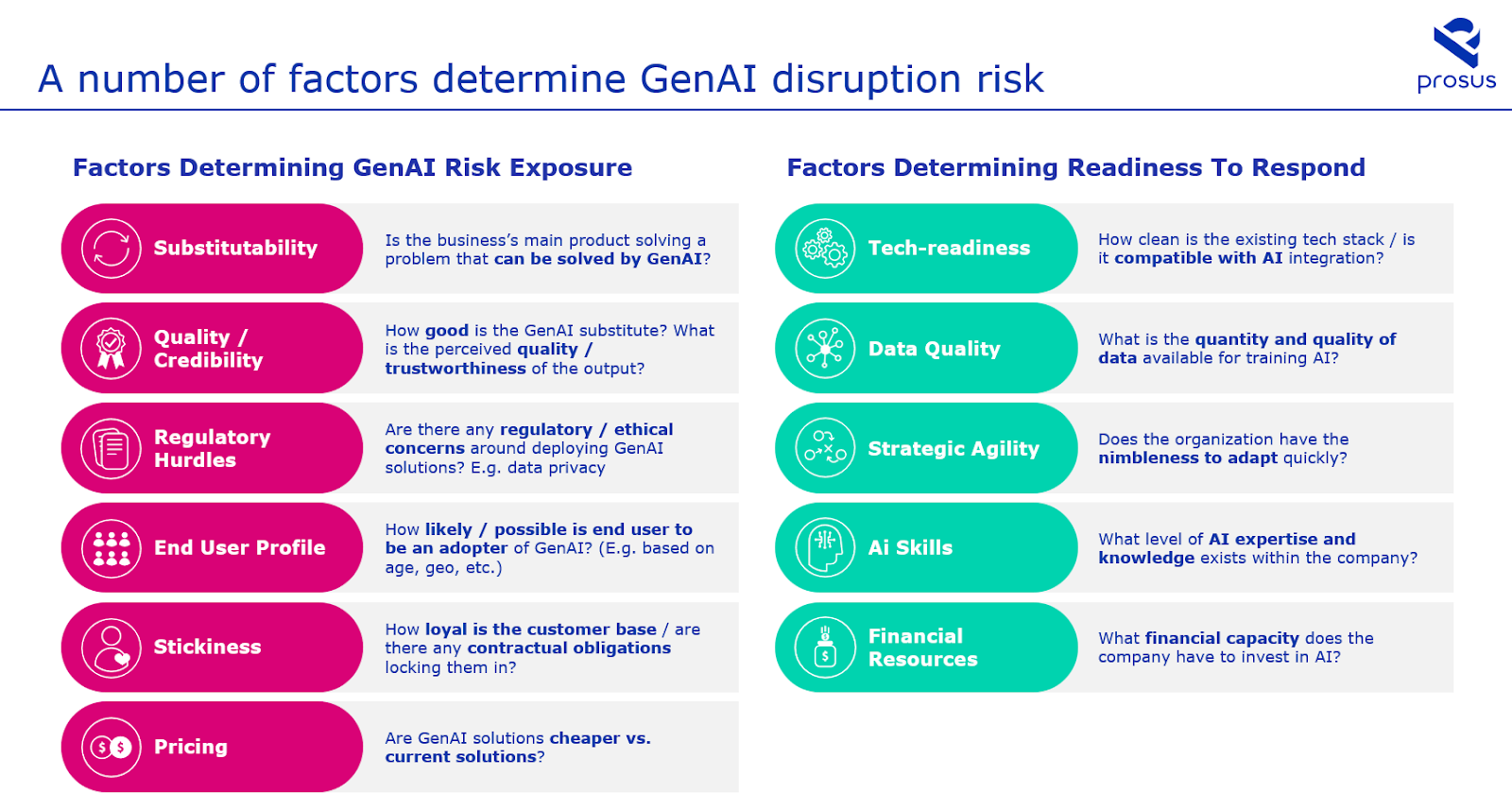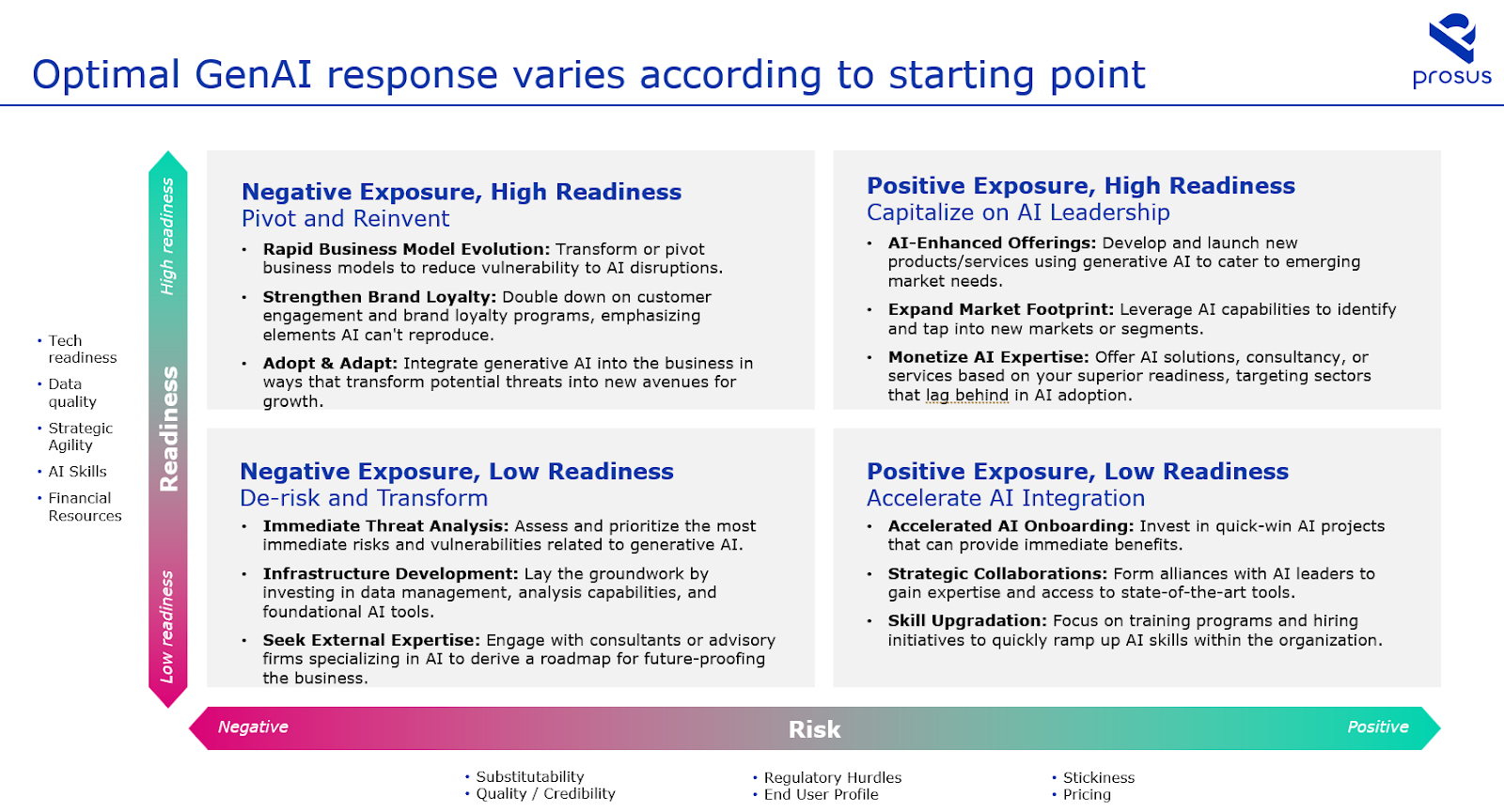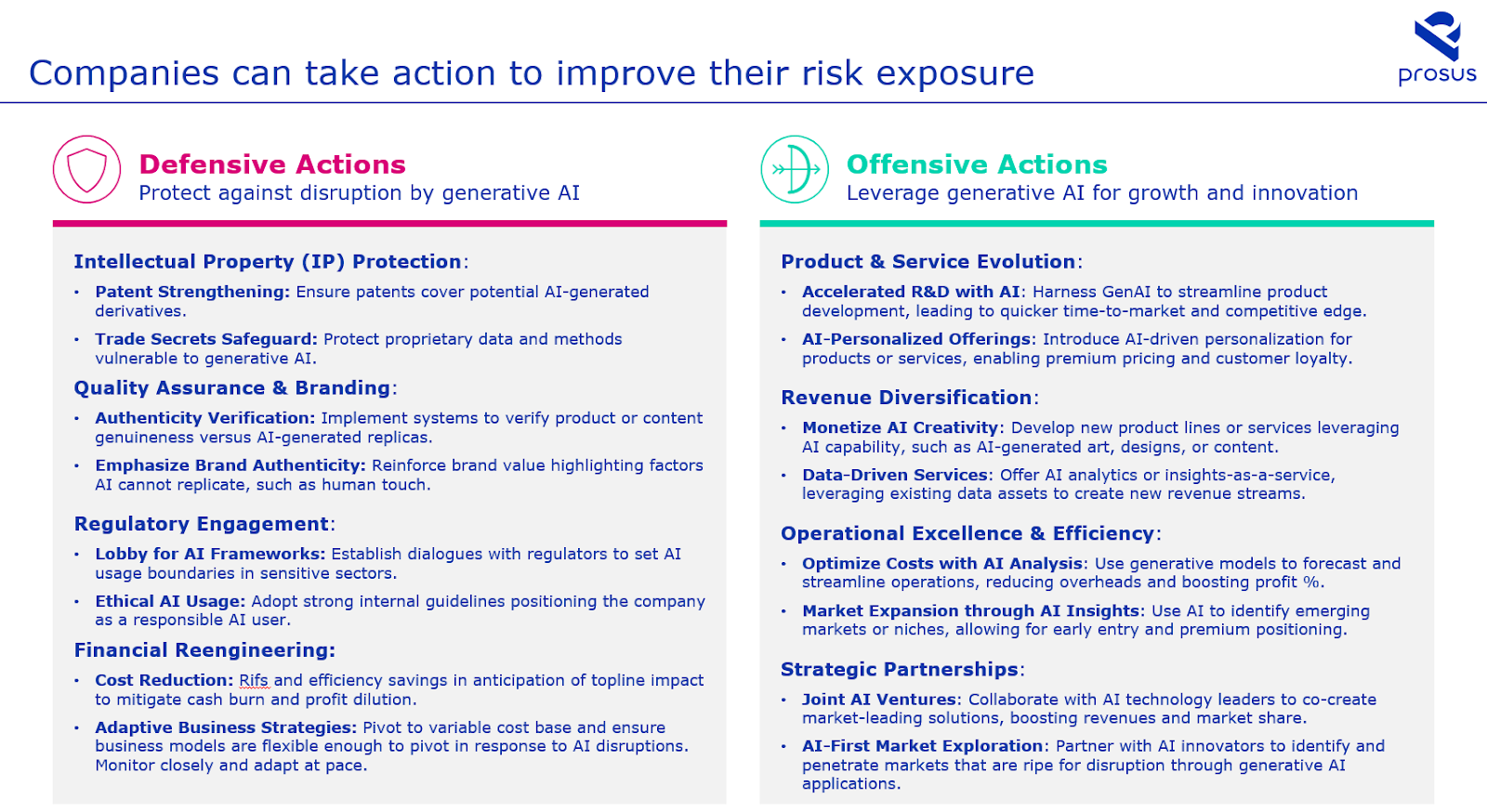Reflecting on the journey since ChatGPT’s debut a year ago, it’s clear that generative AI (GenAI) is more than a technological trend; it’s a pivotal shift in the business landscape.
With almost two decades of experience in strategic and operational roles at McKinsey, eBay, Nike, and now at Prosus, I have focused on translating emerging technologies into strategies that drive meaningful business growth and value. At Prosus, this has involved guiding startups through the GenAI landscape, helping them not just adapt, but also win in a market that is rapidly transforming.
In this article, I distill those learnings into a practical playbook for GenAI, aimed at helping startups to not only survive but also thrive in the GenAI era.
GenAI value creation
Balancing protective measures, like data protection protocols, with progressive strategies, such as AI-driven product rollouts, is essential.
With a dedicated focus on GenAI, our portfolio of companies has been able to realize significant value over the last 12 months across retention, sales pipeline, conversion rates, fraud prevention, and operational efficiency.
While we celebrate these quick wins, the real power of GenAI lies in its ability to lay a foundation for long-term, sustainable success in a constantly evolving landscape.

Figure 1. Example results from Prosus GenAI value creation initiatives. Image Credits: Prosus
Getting practical
Drawing on this hands-on experience, I’ve outlined a three-step process, allowing startups to assess their position, strategize and unlock value.
Disruption diagnostics: Dissect risk and readiness
It is crucial to understand your company’s current standing in relation to GenAI disruption. This involves a thorough analysis of risk exposure and operational readiness, which provides a foundation for a robust GenAI strategy.

Figure 2. Factors determining GenAI risk exposure and readiness to respond. Image Credits: Prosus
Craft the blueprint: Create a tailored strategy
Next, shape your strategy based on where you stand in the risk versus readiness matrix. This approach is key for startups, allowing you to tailor your plan to both the potential impact of GenAI in your industry and your current ability to adapt.
Negative-exposure, low-readiness (Figure 2, lower left) companies face a “code red” situation. If GenAI threatens their core business, they must act fast. The first step is ramping up readiness, bringing in external expertise and building in-house capabilities. The next, more radical step (Figure 2, upper left) is to “pivot and reinvent,” stripping back to core assets and reimagining their use for sustainable value creation.
On the other hand, positive-exposure, high-readiness (Figure 2, upper right) companies are primed to capitalize on AI leadership. They’re in a great position to boost productivity, enhance user experience, and roll out new products and services. Our portfolio companies are leading the way here — from training proprietary models with their own data, to developing specialized copilots, to reinventing search and personalization on a massive scale.

Figure 3. Risk vs. readiness GenAI impact matrix. Image Credits: Prosus
Manage risk: Marry defense with offense
For those startups with a more conservative nature, there can be a temptation to stick with what they know, prioritizing defensive measures to shore up old business models and technology stacks. Conversely, with those who lean toward aggressive moves, there can be a desire to jump wholesale into a new model — with total disregard for what made the company a success in the first place.
Practical experience shows that balancing protective measures, like data protection protocols, with progressive strategies, such as AI-driven product rollouts, is essential. Finding a balance ensures risk mitigation while maximizing the benefits of GenAI.

Figure 4. Defensive and offensive actions to protect against disruption. Image Credits: Prosus
Unlocking organizational insights
Having established the “What” in steering a company toward a GenAI-powered future, it is equally important to look at the “How” of its approach.
Considering the cultural and behavioral dimensions of the organization is equally essential when embarking on this transformative journey. To navigate this rapidly changing landscape, companies must focus on the following:
- Stay abreast of technology trends: The world of GenAI is moving so fast that what was the leading edge three months ago has now been superseded. It is essential to keep a close eye on technological advancements and continually assess their impact on your direction and approach.
- Support dedicated focus: Responding to GenAI cannot be a side project. Allocate resources and teams specifically for exploring GenAI’s potential within your organization.
- Cultivate expertise: AI expertise isn’t cheap or easy to get, but missing the wave is likely to be even more costly. Invest in GenAI knowledge and practical skills, as they’re crucial for staying ahead.
- Foster collaboration: GenAI impacts all aspects of a business, from technology stack to revenue model. Building a response to GenAI is a team sport — it requires collaboration across the company, including product, engineering, marketing, sales, legal, and finance.
- Show vision: Success requires the rethinking of what it means to be “visionary.” It is challenging to be visionary when you don’t have all the answers and can’t know how things will work out. Leaders must be closely in tune with technological developments to anticipate future trends.
- Engineer value: In the GenAI era, it’s not just about adopting new technologies but developing products and services that consumers genuinely want and are willing to pay for. It’s crucial to balance innovation with practicality and cost-effectiveness to create sustainable value using GenAI.
- Partner to win: In a field as vast and complex as GenAI, partnerships can be a powerful lever for success. Look for opportunities to collaborate with technology providers, industry peers, and research institutions. These alliances can provide access to specialized skills, shared resources, and cross-sector insights.
- Embrace resilience and humility: Encourage experimentation and be open to new approaches, basing decisions on reality, not just hype. The path of innovation is often nonlinear and requires an ability to adapt and learn from setbacks.
Navigating the GenAI era
As GenAI’s first year draws to a close, startups find themselves at a critical juncture. In a climate where capital is costlier, every dollar must work harder, making efficiency and value creation more important. GenAI emerges as a key lever in this environment, offering startups a way to stretch their resources further while driving growth. Yet, the imperative of GenAI goes beyond immediate efficiency; it’s about future-proofing businesses against the risk of becoming obsolete in a fast-evolving digital landscape.
This three-step process offers startups a simple playbook to kick off their GenAI strategy. This approach balances the need for swift adoption of GenAI technologies with the preservation of those core principles that originally spelled success for these companies.
As we stand at the dawn of a future shaped by GenAI, it’s clear that navigating this new era is a collaborative journey. Embracing GenAI with focus and investing in AI expertise are vital for a successful transition. Entrepreneurs and leaders who will excel in the GenAI era are those who combine vision with humility and who are committed to continuous learning and adaptability.
For startups facing this transformation, success will hinge on their ability to blend foresight, flexibility, and a strong commitment to innovation that drives real value. This blend is the new benchmark for leadership in any industry, turning the challenge of GenAI into opportunities for enduring success.
